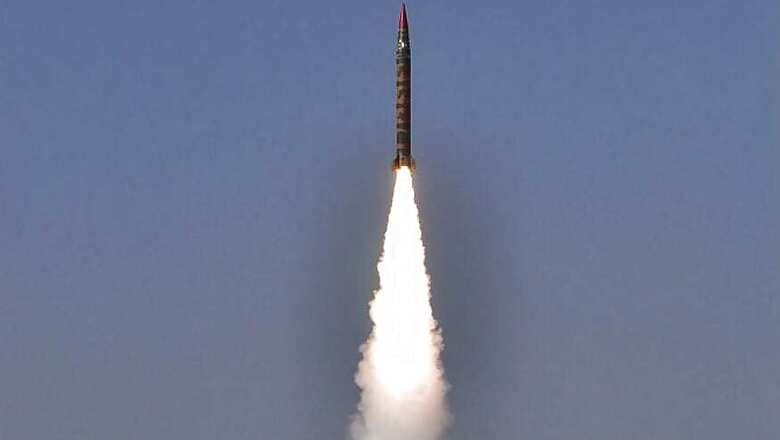
views
New Delhi: Dr Pervez Hoodbhoy, a nuclear physicist formerly with the Qaid-e-Azam University in Islamabad, is considered the pre-eminent scholar on Pakistan’s nuclear project. A political activist in his own right, Dr Hoodbhoy is currently the Professor of Mathematics & Physics at the Forman Christian College in Lahore. He spoke to News18’s Tushar Dhara over the telephone from Lahore on Pakistan’s options, including nuclear and tactical, in the wake of India’s surgical strikes avenging the Uri attack.
Q. What is your view of the surgical strikes that India conducted?
In Islamabad these are being viewed as normal exchanges of artillery across the Line of Control (LoC). The notion that surgical strikes have occurred is being rejected here. People are saying that this is something the Indians are fabricating in order to please their own public and actually on the ground there is only cross-border shelling, which has been happening for a very long time.
Q. What is the course of action Pakistan is likely to take now? Will it include a nuclear option?
Unless things escalate there will be no use of nuclear weapons. The use of nuclear weapons would essentially be the end of both countries and that is not a decision that will be taken very lightly, hopefully never be taken. But at the moment both countries are going to push each other and try to do the maximum damage without crossing the nuclear threshold.
We have certainly not crossed it, but the efforts of hawks on both sides of the border is to push us closer and closer to that red line.
Q. Do you think there will be de-escalation from here?
A. Unless good sense prevails, we shall keep getting closer, and one hopes there will be international diplomatic pressure as well as domestic pressure from those concerned with their own survival, both in India and Pakistan, that will prevent the hawks from getting the upper hand, because the hawks have no idea what to do. Once they get right to the threshold then there could be a point of no-return, and if that is reached there would be neither hawks nor doves anywhere.
Q. Are the doves or the hawks winning in Pakistan right now?
The media, which is influenced heavily by the [Pakistan] Army, is full of threatening voices and of voices that seek to belittle the other side and drum up jingoistic sentiments and it is a very ugly scene that is reminiscent of earlier tensions with India, tensions that in the past have led to war.
Q. What is the form of escalation that Pakistan could take?
It is General Raheel Sharif who will have an influence on the forces, after all these are the forces that are directly under his command, and he will make the decision as to what level of tension is to be reached. I suspect that he will be talking to Prime Minister Nawaz Sharif to tell him this is what we are going to do.
Q. Can you give an idea about the command and control structure of Pakistan’s Nuclear weapons?
Pakistan’s nuclear weapons are under the control of the National Command Authority (NCA). Members of the NCA include the Chief of the Army Staff, who is of course going to be the most important member of this committee. But also there will be the other service chiefs of the Navy and Air Force, as well as the Prime Minister, the minister of defence and the head of the Strategic Plans Division.
Q. How does Pakistan view the Indian surgical strike with respect to nuclear weapons?
If India moves to sever Pakistani communication links between the north and the south of the country, or if it attempts to impose a blockade upon Karachi…in that case the situation will have reached a very high level of seriousness, and the situation could go out of control at that point. However, the two countries have accommodated a certain level of shelling across the border and I suspect that the intensity of that is going to rise in the days ahead.
Q. How does India’s publicly stated policy of “no first-use” with regards to nuclear weapons contrast with Pakistan’s stance that eschews such a policy?
I think “first use” or “no first-use” are entirely declaratory, there is no means of ensuring that India will not use its nuclear weapons first, even though it says it will not.
Pakistan says its nuclear weapons are for defensive purposes only.
Q. In what case would Pakistan use tactical nuclear weapons? Do the surgical strikes by India take Pakistan a step closer to using them?
Tactical nuclear weapons and strategic nuclear weapons are not very different from each other, although tactical weapons are smaller in size. It is the nature of the target that makes the two different from each other. Tactical weapons strike at military formations and troop concentrations whereas strategic ones aim for population centres, industrial centres, dams etc. They seek to inflict the maximum amount of civilian casualties.
Q. Can you talk about the role of the United States and China on Pakistan’s nuclear policy?
A. The United States has very little influence on Pakistan’s nuclear policy and affairs. Its knowledge of the whereabouts of Pakistan’s nuclear weapons is also very limited. That space has been vacated, not because the United States wanted to but because of the bad relations that Pakistan developed with the US over Afghanistan. So today the only external country that has a major influence on Pakistan is China. However, China is unlikely to exercise much diplomatic pressure, and therefore India and Pakistan are at a more dangerous place than ever before because at earlier times the United States and Britain could be pressed into action in order to resolve tensions between India and Pakistan.




















Comments
0 comment